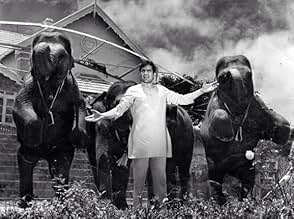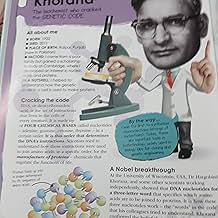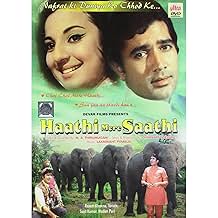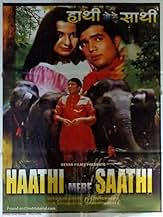IMDb रेटिंग
6.9/10
1.4 हज़ार
आपकी रेटिंग
अपनी भाषा में प्लॉट जोड़ेंRaju becomes very attached to his four elephants after they save his life. His wife, however, fears for her child and tells him that he must choose between the animals and his family.Raju becomes very attached to his four elephants after they save his life. His wife, however, fears for her child and tells him that he must choose between the animals and his family.Raju becomes very attached to his four elephants after they save his life. His wife, however, fears for her child and tells him that he must choose between the animals and his family.
- पुरस्कार
- कुल 2 जीत
फ़ीचर्ड समीक्षाएं
As a kid, I loved Haathi Mere Saathi. Today, I'm not particularly eager to revisit it though it's definitely a memorable picture. The film portrays a friendship between a young orphaned and wealthy man and his group of elephants, who had once saved him when he was lost in a jungle. The film was generally well made and several Indian movies were inspired by this story afterwards. The script is well written and the movie has its share of enjoyable moments even if the concept itself is hard to believe. The songs, the proceedings and the development were pretty fun to watch, despite being a bit melodramatic at points. Rajesh Khanna stars as Raj and he is a good hero for this film. This was the year when his performance in Hrishikesh Mukherjee's Anand wowed audiences. His work here does not even deserve a comparison to the latter, but he is the main reason the movie works, and frankly speaking I've never been a big fan of his films and liked very few of his performances. Tanuja is very pretty as his wife. The supporting cast is good but the elephants are those who leave a mark. Their loyalty and wisdom were funny and inspiring at the same time. Haathi Mere Saathi is a nice film. It has many moments of comedy, drama and heartwarming fun, and despite having its flaws, it's worth watching, particularly for lovers of Hindi films.
(Rated on the basis of watching on T.V. 41 years after release)
Plot: A little boy, Raju grows up with a group of elephants who become his soul-mates. But can they live happily ever after?
Review: Children's cinema was a rarity in the 70's decade which was dominated by action-dramas. But one big exception was "Haathi Mere Saathi"(1971), directed by M.A.Thirumugham which was inspired from his own Tamil hit, "Vettaikkaaran"(1964).
The screenplay was penned by the legendary script-writing duo of Salim- Javed, who here were making their debut. It was a story about friendship, loyalty, misunderstanding and sacrifice. But unlike other films, here this message was spread through a bond between humans and the immensely lovable, elephants! Brilliantly written; it packed in all the essential elements- a tense beginning, romance, a tragic twist, fight-back, misunderstanding and a high-octane climax packed by several heart-warming and heart-wrenching moments! The script laid the solid foundation on which the pachyderms & co. stole the show.
In those days, it wasn't prevalent to take the little ones to watch movies; especially Hindi films! They were either too violent or too romantically matured. But they never missed out in case a film like "Haathi Mere Saathi" came around. While the parents shied away their children from other Rajesh Khanna hits like "Aradhana", "Amar Prem", and "Daag"; there was no escaping the charm of the then-reigning-superstar of Bollywood in this flick. But the undeniable superstars here were the tuskers who won our hearts with their frolics and actions displaying a superb mixture of innocence and intelligence. They made the humans look like supporting actors to them. Hats off to their trainers! But it would be a terrible mistake to believe it is just an elephant-based film going by the title. The lions, tigers, bears and alligators, all deserve their place of honour. However incredible the antiques of the tuskers appeared; the wedding-feast sequence and the climax-song where the cast members are surrounded by these four-legged friends, are jaw-dropping and drop-dead stunning! One must rub their eyes in disbelief. They were one surprise the viewers were least expecting but couldn't thank their stars enough for witnessing it. The circus-stunts (especially, the jump from the tower after the hero sets himself on fire) are bonus treats for children and grown-ups alike! The last half-an-hour strike a hammer blow in the viewers' hearts; but yet one would only take back happy memories from the film.
Rajesh Khanna slipped into his role with typical élan. He consciously portrayed himself as a friend of the animals, never as a master. It was tough to be convincing as someone whose orders are obeyed by wild animals. But he pulled it off with his trademark grace and ever-charming smile. Tanuja looked gorgeous and portrayed the concerns of an insecure mother, convincingly. She shared a sweet and lovely chemistry with 'Kaka'; it's a pity we didn't get to see this pair in too many films. It was surprising to see Sujit Kumar play a negative role, but he did full justice to it. The remaining cast including Madan Puri and Jr. Mehmood were good as well. But the best performers undoubtedly were the non- humans; especially the elephant, Ramu who put in the most assured performance. There are just no words to describe him. Take a bow, Ramu!
The title-track, having superb antaras, is the best song of the film; all of which are scored by Laxmikant-Pyarelal. 'Nafrat Ki Duniya' is brilliantly sung by Rafi; though the attention got diverted by its spell-binding picturisation on 'Kaka' surrounded by tigers and lions on both sides. 'Dilbar Jani' and 'Duniya Mein Jeena' are also praise-worthy tracks. The composers must also be lauded for the impressive theme-score where trumpets were used to replicate the voice of the tuskers.
Although commendably written, the script lacks logic at places. The basic premise itself of a man affording to keep four elephants is hard to believe. The 'munshi', who bought ration for the elephants from his own pocket, didn't seem so money-minded to switch allegiances. It was more incredible that Raju could feed himself and four elephants with a daily earning of just Rs.250 when they were driven out on the streets! Lastly, the rise of Raju from a street-performer to the owner of a private zoo was too swift to be convincing. His progress needed to be depicted in more detail.
But the biggest deficiency in the film, which prevents it from being termed 'great', is its sub-standard editing. Also handled by the director himself, he fails to replicate his skills behind the camera on the editing table. The first signs were evident from the thrilling elephant-leopard tussle at the beginning; but one could excuse that considering the difficulty in executing the shot. But it was unacceptable when shots were repeated in a couple of songs and the same close-up of an elephant's eye being used repeatedly. The two sequences of shooting of elephants, Tanu's father lying to her about Raju and Raju lying ill in a temple are clumsily edited. Poor editing injects apprehension into the viewers' mind regarding the style of unfolding of the film as the editor is the overseer of the final product. The editing sticks out like a sore thumb in this otherwise gem of a film.
"Haathi Mere Saathi" spreads a message of harmony (exemplified by the peaceful co-existence of lions and goats together). It will live on as an ideal film for children but it sends out important lessons for grown- ups as well. The elephants teach us how to be true human-beings.
Box-Office Verdict: The film became the highest-grossing blockbuster of 1971. The title-track remains popular even after four decades. It also won the National Award and became the last of Rajesh Khanna's unbroken record of 15 consecutive hits. It was remade by the makers in Tamil as "Nalla Neram" in 1972. It's regarded as the finest children's film made in Bollywood.
Plot: A little boy, Raju grows up with a group of elephants who become his soul-mates. But can they live happily ever after?
Review: Children's cinema was a rarity in the 70's decade which was dominated by action-dramas. But one big exception was "Haathi Mere Saathi"(1971), directed by M.A.Thirumugham which was inspired from his own Tamil hit, "Vettaikkaaran"(1964).
The screenplay was penned by the legendary script-writing duo of Salim- Javed, who here were making their debut. It was a story about friendship, loyalty, misunderstanding and sacrifice. But unlike other films, here this message was spread through a bond between humans and the immensely lovable, elephants! Brilliantly written; it packed in all the essential elements- a tense beginning, romance, a tragic twist, fight-back, misunderstanding and a high-octane climax packed by several heart-warming and heart-wrenching moments! The script laid the solid foundation on which the pachyderms & co. stole the show.
In those days, it wasn't prevalent to take the little ones to watch movies; especially Hindi films! They were either too violent or too romantically matured. But they never missed out in case a film like "Haathi Mere Saathi" came around. While the parents shied away their children from other Rajesh Khanna hits like "Aradhana", "Amar Prem", and "Daag"; there was no escaping the charm of the then-reigning-superstar of Bollywood in this flick. But the undeniable superstars here were the tuskers who won our hearts with their frolics and actions displaying a superb mixture of innocence and intelligence. They made the humans look like supporting actors to them. Hats off to their trainers! But it would be a terrible mistake to believe it is just an elephant-based film going by the title. The lions, tigers, bears and alligators, all deserve their place of honour. However incredible the antiques of the tuskers appeared; the wedding-feast sequence and the climax-song where the cast members are surrounded by these four-legged friends, are jaw-dropping and drop-dead stunning! One must rub their eyes in disbelief. They were one surprise the viewers were least expecting but couldn't thank their stars enough for witnessing it. The circus-stunts (especially, the jump from the tower after the hero sets himself on fire) are bonus treats for children and grown-ups alike! The last half-an-hour strike a hammer blow in the viewers' hearts; but yet one would only take back happy memories from the film.
Rajesh Khanna slipped into his role with typical élan. He consciously portrayed himself as a friend of the animals, never as a master. It was tough to be convincing as someone whose orders are obeyed by wild animals. But he pulled it off with his trademark grace and ever-charming smile. Tanuja looked gorgeous and portrayed the concerns of an insecure mother, convincingly. She shared a sweet and lovely chemistry with 'Kaka'; it's a pity we didn't get to see this pair in too many films. It was surprising to see Sujit Kumar play a negative role, but he did full justice to it. The remaining cast including Madan Puri and Jr. Mehmood were good as well. But the best performers undoubtedly were the non- humans; especially the elephant, Ramu who put in the most assured performance. There are just no words to describe him. Take a bow, Ramu!
The title-track, having superb antaras, is the best song of the film; all of which are scored by Laxmikant-Pyarelal. 'Nafrat Ki Duniya' is brilliantly sung by Rafi; though the attention got diverted by its spell-binding picturisation on 'Kaka' surrounded by tigers and lions on both sides. 'Dilbar Jani' and 'Duniya Mein Jeena' are also praise-worthy tracks. The composers must also be lauded for the impressive theme-score where trumpets were used to replicate the voice of the tuskers.
Although commendably written, the script lacks logic at places. The basic premise itself of a man affording to keep four elephants is hard to believe. The 'munshi', who bought ration for the elephants from his own pocket, didn't seem so money-minded to switch allegiances. It was more incredible that Raju could feed himself and four elephants with a daily earning of just Rs.250 when they were driven out on the streets! Lastly, the rise of Raju from a street-performer to the owner of a private zoo was too swift to be convincing. His progress needed to be depicted in more detail.
But the biggest deficiency in the film, which prevents it from being termed 'great', is its sub-standard editing. Also handled by the director himself, he fails to replicate his skills behind the camera on the editing table. The first signs were evident from the thrilling elephant-leopard tussle at the beginning; but one could excuse that considering the difficulty in executing the shot. But it was unacceptable when shots were repeated in a couple of songs and the same close-up of an elephant's eye being used repeatedly. The two sequences of shooting of elephants, Tanu's father lying to her about Raju and Raju lying ill in a temple are clumsily edited. Poor editing injects apprehension into the viewers' mind regarding the style of unfolding of the film as the editor is the overseer of the final product. The editing sticks out like a sore thumb in this otherwise gem of a film.
"Haathi Mere Saathi" spreads a message of harmony (exemplified by the peaceful co-existence of lions and goats together). It will live on as an ideal film for children but it sends out important lessons for grown- ups as well. The elephants teach us how to be true human-beings.
Box-Office Verdict: The film became the highest-grossing blockbuster of 1971. The title-track remains popular even after four decades. It also won the National Award and became the last of Rajesh Khanna's unbroken record of 15 consecutive hits. It was remade by the makers in Tamil as "Nalla Neram" in 1972. It's regarded as the finest children's film made in Bollywood.
Now, kill me if I can remember anything in particular about this movie. Beside the fact that it was 3 hours long and I spilled tones of tears during that time. No other film had made me cry so much for no reason at all. There is some hidden sentimentality in human species that makes him cry - most often some sad event of Bereavement - but in cinema there are instances unexplained. So it was the soundtrack of this Bollywood movie that has remained unchallenged hit for all times in Hindu cinema.
My personal memories from 40 years ago reveal the phenomenon of full cinema saloons with standing people interspersed between rows. Most were Gypsies of various age. That doesn't mean that Bulgaria (that's me) as a full member of European Union is Gypsy state. Most of them are of mixed origins, some of them cohabit with the Turks minority and at least half of that vagrant population is Christian. It's a matter of cultural adaptation and educational policy.
I see from the release info that "Haathi Mere Saathi" (1971) was projected only in Portugal and Bulgaria. Gosh, why don't you see it in America as well. Hundred percent guarantee that the end scene where elephant is being shot in the eye would heal your heart. Actors / actresses are beautiful by any standard and cars are fashionable. Thank you!
My personal memories from 40 years ago reveal the phenomenon of full cinema saloons with standing people interspersed between rows. Most were Gypsies of various age. That doesn't mean that Bulgaria (that's me) as a full member of European Union is Gypsy state. Most of them are of mixed origins, some of them cohabit with the Turks minority and at least half of that vagrant population is Christian. It's a matter of cultural adaptation and educational policy.
I see from the release info that "Haathi Mere Saathi" (1971) was projected only in Portugal and Bulgaria. Gosh, why don't you see it in America as well. Hundred percent guarantee that the end scene where elephant is being shot in the eye would heal your heart. Actors / actresses are beautiful by any standard and cars are fashionable. Thank you!
Haathi Mere Saathi is drama film directed by Late M. A. Thirumugam. The film stars Late Rajesh Khanna, Tanuja, late Madan Puri, Late Sujit Kumar and Late K. N. Singh.
Raju becomes very attached to his four elephants after they save his life. His wife, however, fears for her child and tells him that he must choose between the animals and his family.
The film which is one of the most entertaining film and was liked by adults and kids at the time of it's release was also considered as one of the biggest hit of not only Hindi cinema but also of the career of Rajesh Khanna and also paved the way for a new genre in Indian cinema.
The plot of the film is unique at the time the film was made and execution is good. The pace of the film is also good and is supported by some good songs which doesn't effects the pace of the film.
Screenplay of the film is decent but the viewers of current era might feel the film long, exhausting and cliched but the era the film was released it was normal and people loved such films.
Acting is decent and none of them were very impressive nor very disappointed as we have seen them doing similar acting in many films.
All the songs of the film are good specially the title track. Climax and the end of the film is emotional and perfect.
Can be watched once and the children will surely like this film.
Raju becomes very attached to his four elephants after they save his life. His wife, however, fears for her child and tells him that he must choose between the animals and his family.
The film which is one of the most entertaining film and was liked by adults and kids at the time of it's release was also considered as one of the biggest hit of not only Hindi cinema but also of the career of Rajesh Khanna and also paved the way for a new genre in Indian cinema.
The plot of the film is unique at the time the film was made and execution is good. The pace of the film is also good and is supported by some good songs which doesn't effects the pace of the film.
Screenplay of the film is decent but the viewers of current era might feel the film long, exhausting and cliched but the era the film was released it was normal and people loved such films.
Acting is decent and none of them were very impressive nor very disappointed as we have seen them doing similar acting in many films.
All the songs of the film are good specially the title track. Climax and the end of the film is emotional and perfect.
Can be watched once and the children will surely like this film.
I first saw this film in India when I was 5 years old. I remembered that I really liked it then, and was quite pleased to find it 30 years later via the Internet.
I'm glad to say that it has lost none of its magic. The story of Raju and his elephant buddy Ramoo makes for a truly unique film. The best way I can sum it up, without giving too much away, is that it is reminiscent of older Disney films, but with a uniquely Indian feel. Suffice to say, there are not many countries in the world where a story of a man growing up with elephants could be told in such an effective manner. The trained animal sequences alone are worthy of films such as "The Bear".
With regards to the inevitable singing and dancing in a Bollywood production, the songs are wonderful and there are far fewer of them than in standard Bollywood fare. Additionally, as opposed to the more modern Indian films, the dancing is refreshingly non-professional and consists mostly of the hero and heroine scampering about and waving their arms - which only adds to the overall charm of this film.
I'm glad to say that it has lost none of its magic. The story of Raju and his elephant buddy Ramoo makes for a truly unique film. The best way I can sum it up, without giving too much away, is that it is reminiscent of older Disney films, but with a uniquely Indian feel. Suffice to say, there are not many countries in the world where a story of a man growing up with elephants could be told in such an effective manner. The trained animal sequences alone are worthy of films such as "The Bear".
With regards to the inevitable singing and dancing in a Bollywood production, the songs are wonderful and there are far fewer of them than in standard Bollywood fare. Additionally, as opposed to the more modern Indian films, the dancing is refreshingly non-professional and consists mostly of the hero and heroine scampering about and waving their arms - which only adds to the overall charm of this film.
क्या आपको पता है
- ट्रिवियाSeveral years later actress Tanuja took her daughter Kajol to the circus. A elephant grabbed Tanuja' s pallu and would not leave it. Tanuja wondered as to why the elephant was behaving this way. It was then she was informed that the elephant was one the elephants used for her film " Haathi Mera Saathi". The elephant had recognized her despite so many years passing.
- साउंडट्रैकChal Chal Chal Mere Saathi
Performed by Kishore Kumar & Lata Mangeshkar
Music by Laxmikant-Pyarelal
टॉप पसंद
रेटिंग देने के लिए साइन-इन करें और वैयक्तिकृत सुझावों के लिए वॉचलिस्ट करें
- How long is Elephants Are My Friends?Alexa द्वारा संचालित
विवरण
- रिलीज़ की तारीख़
- कंट्री ऑफ़ ओरिजिन
- भाषा
- इस रूप में भी जाना जाता है
- Haathi Mere Saathi
- फ़िल्माने की जगहें
- उत्पादन कंपनी
- IMDbPro पर और कंपनी क्रेडिट देखें
- चलने की अवधि
- 2 घं 50 मि(170 min)
- ध्वनि मिश्रण
इस पेज में योगदान दें
किसी बदलाव का सुझाव दें या अनुपलब्ध कॉन्टेंट जोड़ें
































